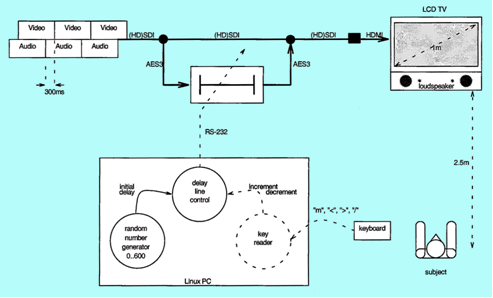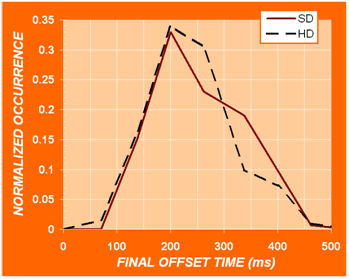|
AES
PAPER ON PERCEPTION OF AUDIO-VIDEO SYNCHRONIZATION
 The
125th Convention of the Audio Engineering Society (AES), held
in San Francisco from October 2-5, included a paper entitled Factors
Affecting Perception of Audio-video Synchronization in Television
by Andrew Mason and Richard Salmon of the British Broadcasting
Corporation (BBC) in the United Kingdom. This paper reports on
research being carried out at the BBC Research Laboratories into
audio-video synchronization (A-V sync), specifically in the area
of human perception of synchronization errors. The
125th Convention of the Audio Engineering Society (AES), held
in San Francisco from October 2-5, included a paper entitled Factors
Affecting Perception of Audio-video Synchronization in Television
by Andrew Mason and Richard Salmon of the British Broadcasting
Corporation (BBC) in the United Kingdom. This paper reports on
research being carried out at the BBC Research Laboratories into
audio-video synchronization (A-V sync), specifically in the area
of human perception of synchronization errors.
The timing
relationship between audio and video in television is commonly
referred to as "lip sync." As noted in the paper, this
term originates from observation of television pictures showing
a person talking, where a mismatch of more than a few tens of
milliseconds between the sounds heard and the pictures seen can
ruin the illusion that is television: the motion of the talker's
lips should be correctly synchronized with the sounds heard. In
the paper, the concept of correct synchronization, and some of
the technical and psychological factors that can affect perception
of the correctness a televisual presentation, are discussed. Also
noted is the fact that several international organizations are
actively working in the field of audio video synchronization,
with the aim of reducing the accumulation of errors that often
plague television broadcasts.
The first
part of the paper discusses the role that acquisition, production,
processing, and reproduction equipment may play in the introduction
of synchronization errors, focusing on:
| Camera
types |
Vision
mixer |
| Router |
Video
synchronizer |
| Audio
mixer |
Standards
conversion (change of frame rate) |
| Aspect
ratio conversion |
Digital
video effects (DVE) |
| Low bit
rate coding, including DVB |
Sample
frequency conversion |
| Audio
dynamic range compression |
Displays |
| Loudspeakers
and acoustic environment |
Audio
processing in the receiver |
 The
paper describes how all these factors can contribute to A-V sync
errors, some small but some of multiple frames duration, if delays
are not compensated. The paper also states that mishandling of
MPEG system time clock (STC) and presentation time stamps (PTS)
in DTV receivers are a source of much of the perceived mistiming
in broadcast television reception. The
paper describes how all these factors can contribute to A-V sync
errors, some small but some of multiple frames duration, if delays
are not compensated. The paper also states that mishandling of
MPEG system time clock (STC) and presentation time stamps (PTS)
in DTV receivers are a source of much of the perceived mistiming
in broadcast television reception.
Of particular
interest is an experiment, described in the paper, designed to
assess the effect of image resolution on audio-video synchronization
perception, comparing 625 SD to 1080i HD (both at 25 fps). The
test set-up is shown in the block diagram above; viewers were
asked to correct a 300 ms offset between an audio and a video
signal, for both SD and HD images, and the final offset value
(as established by the viewer) was noted. Some preliminary results
from this experiment are shown in the graph, which illustrates
the probability that a particular final time offset was selected,
with larger "normalized occurrence" values  representing
a higher likelihood. (Note that because of other delays in the
experimental apparatus, the "FINAL OFFSET TIME" scale
in the figure is a relative scale and does not represent the actual,
final offset between the audio and the video.) These results,
while not showing a major difference between lip sync perception
for SD and HD images, do indicate some differences. representing
a higher likelihood. (Note that because of other delays in the
experimental apparatus, the "FINAL OFFSET TIME" scale
in the figure is a relative scale and does not represent the actual,
final offset between the audio and the video.) These results,
while not showing a major difference between lip sync perception
for SD and HD images, do indicate some differences.
While viewers
were most likely to select a final offset time of 200 ms for either
SD or HD, note that the distribution of the SD results is wider
than that of the HD results, suggesting that accurate lip-sync
is less critical for SD images than for HD. The authors believe
that additional studies would be useful to further characterize
this behavior.
The next part of the paper discusses the work being done by other
organizations in the field of A-V sync. It mentions the work in
the International Electrotechnical Commission (IEC), Advanced
Television System Committee (ATSC), the Society of Motion Picture
and Television Engineers (SMPTE, led by a member of NAB Science
and Technology staff), European Broadcasting Union (EBU), and
the AES.
The final
part of the paper describes objective and subjective methods for
measurement of A-V sync developed by the BBC. The "electronic
clapperboard system" described has many similarities to a
system developed by Sarnoff Corporation and described in October
29, 2007 issue of TV TechCheck.
A copy of
the complete AES paper will be available for purchase on the AES
Web page soon - go to www.aes.org/publications/preprints/
and look for the link to the AES 125th Convention, San Francisco,
Calif.
FCC
Reminds Television Stations to Update Their DTV Transition Status
Report - FCC Form 387 - By October 20, 2008
On October
10, 2008 the FCC's Media Bureau issued a public notice reminding
TV stations of their obligation to update Form 387 by October
20, 2008. The FCC adopted the requirement for stations to periodically
file a DTV Transition Status Report in the Third DTV Periodic
Review Report and Order. All television stations that have not
reported on their DTV Transition Status Report that their post-transition
DTV facilities are "fully operational," must update
their DTV Transition Status Report by October 20, 2008. Stations
should report the current status of their efforts to complete
their post-transition DTV facilities and should report any change
to the information contained in their previous DTV Transition
Status Report. The Public Notice states that although detailed
explanations concerning the DTV transition status may be filed
as an exhibit, stations must complete all relevant boxes on their
DTV Transition Status Report. It also states that the information
is important in order for the FCC to be able to determine whether
stations are on track to complete the DTV transition on time.
Form 387 must
be updated electronically using the FCC's Consolidated Database
System ("CDBS") Electronic Filing System on the Media
Bureau's Web site at:
http://www.fcc.gov/mb/cdbs.html or http://fjallfoss.fcc.gov/prod/cdbs/forms/prod/cdbs_ef.htm.
For more information see the Public Notice here: http://hraunfoss.fcc.gov/edocs_public/attachmatch/DA-08-2264A1.pdf,
or contact the Media Bureau's Video Division: Nazifa
Sawez, Nazifa.Sawez@fcc.gov, at (202) 418-7059, or Shaun
Maher, Shaun.Maher@fcc.gov, at (202) 418-2324.
Deadline
Extended for 63rd NAB Broadcast Engineering Conference
Call for Papers
 NAB
Show will host the 63rd NAB Broadcast Engineering Conference on
April 18 - 23 at the Las Vegas Convention Center in Las Vegas,
Nevada. NAB
Show will host the 63rd NAB Broadcast Engineering Conference on
April 18 - 23 at the Las Vegas Convention Center in Las Vegas,
Nevada.
The
NAB Broadcast Engineering Conference is a highly technical conference
where presenters deliver technical papers ranging over a variety
of topics relevant to the broadcast and allied industries. We
invite you to submit a proposal to present a technical paper
at our conference. The deadline for submitting your proposal
is October 27, 2008.
To submit
a technical paper proposal, click
here and complete the electronic form. If you have questions
regarding the NAB Broadcast Engineering Conference, please contact
John Marino.
 
It's Not Too Late
to Register for the 58th Annual IEEE Broadcst Symposium
The
IEEE Broadcast Technology Society
58th ANNUAL IEEE BROADCAST SYMPOSIUM
Managing the Transitions
15 - 17 October 2008
The Westin Alexandria
Alexandria, VA
Keynote
speakers to include: Richard E. Wiley, Wiley Rein, LLP and Peter
Fannon, Panasonic Corporation.
Please visit the Registration
page for additional information.
ATSC Digital
VSB Measurements Seminar
Monday, October 20, 2008
Sheraton Indianapolis Hotel & Suites
Indianapolis Ind.
A one-day
seminar on the ATSC’s digital television (DTV) vestigial
sideband (VSB) transmission system measurement methodologies will
be presented on October 20 in Indianapolis Ind. Presented by DTV
transmission engineer, Gary Sgrignoli, the seminar identifies
and describes the pieces of test equipment needed for VSB testing
in the laboratory, at transmitter sites and at remote field sites.
For additional
information contact Gary Sgrignoli, Meintel, Sgrignoli & Wallace
at (847) 259-3352 or Gary.Sgrignoli@IEEE.org.


The
October 13, 2008 TV TechCheck is also available
in an Adobe Acrobat file.
Please click
here to read the Adobe Acrobat version of TV TechCheck.
|

